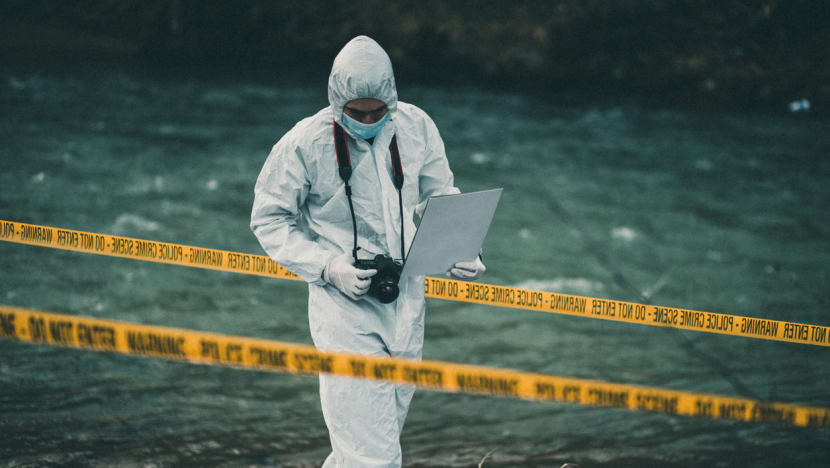Commentary: Size matters when it comes to Singapore’s DNA database
If someone has not done anything wrong, DNA collection will serve as a very good tool to eliminate them from the pool of suspects, says forensics expert Associate Professor Stella Tan.

File photo of a shirt with blood at a crime scene. (Photo: iStock/D-Keine)
SINGAPORE: A battered female body in a bloodstained flat in Ang Mo Kio. A bloody shoe print. Multiple stab wounds on the neck from a nail file. Cigarette butts on newspapers.
For eight years, the 1996 murder of 51-year-old Jetkor Miang Singh in her flat went unsolved. Then in 2004, DNA samples were taken from an inmate serving time for a drug offence. It matched the saliva on 10 cigarette butts found at the scene of the crime.
The case was finally solved. Zulkarnain Kemat was sentenced to eight years in jail and six strokes of the cane in 2005, becoming the first homicide case in Singapore to be cracked with the DNA database.
The case highlights the importance of Singapore’s DNA database, which was launched in 2004.
The use of DNA for crime solving has been in the spotlight recently, after Parliament last month passed a Bill to widen the scope of DNA collection from more suspects and offenders.
Under the amendments, the police can collect and store DNA from not just registrable crimes such as murder and rape, but also for "eligible" crimes such as voluntarily causing hurt, drink driving and mischief.
There is no doubt these amendments will improve the investigative capabilities of Singapore’s enforcement agencies. But will the expansion of DNA collection make would-be criminals think twice now? Should Singapore now expect crime-solving to go up?
THE CSI EFFECT
People who watch crime shows like CSI and Law & Order might think that finding a killer is only a DNA sample away. Real-life crime fighting is not so straightforward.
Forensic DNA analysis is widely regarded as one of the most powerful tools in forensic science. The development of forensic DNA technology since fingerprinting is unarguably the biggest scientific advancement in tackling crimes. Numerous cases that were otherwise impossible to solve have found successful conclusions due to DNA analysis.
Forensic DNA analysis has been used in Singapore and around the world both as an aid to convict the guilty, as well as to establish innocence.
DNA can be obtained from evidence that contains saliva, sweat or semen. Physical evidence collected from a crime scene, such as a knife, or a used condom, may contain DNA of the persons who were in contact with them.
Due to advancement in forensic DNA analysis, a few cells are sufficient to create a DNA profile. The technology is so sensitive that a person who left his DNA on physical evidence can be identified.

However, having DNA collected from a crime without any corresponding DNA database may not be useful as there would be no reference for comparison. We will not be able to maximise its potential use.
The standards of proving a crime in Singapore have always been high. For all criminal cases, the prosecution needs to prove its case beyond a reasonable doubt.
Even with the expansion of the DNA database, it only serves to improve the probative value of a match of a single piece of evidence. A DNA match between a suspect’s sample and a sample from the crime scene, however, does not automatically guarantee a conviction.
Although DNA serves as a very strong piece of evidence, it is often not sufficient to convict someone of a particular crime. It must always be taken in conjunction with other pieces of evidence and the importance of DNA evidence is impossible to estimate without considering the circumstances of the case.
EVOLUTION OF DNA FORENSICS IN SINGAPORE
DNA forensics have been used as early as 1991 in Singapore, but it was largely confined to direct matching of a suspect’s DNA to that found at the crime scene.
Singapore’s DNA database was launched in 2004, allowing matching of DNA specimens of suspects to those found at the crime scene.
Before Singapore had its own DNA testing laboratory, samples had to be sent overseas for analysis and these could take months. However, with the build-up of Singapore’s own capabilities, DNA testing can be done quickly.
HOW DOES DNA FORENSICS WORK?
DNA is found in the nucleus of every cell in the body, except red blood cells. Except for identical twins, every single person’s DNA is unique.
This is similar to finger impressions recorded in Singapore’s national databank, assisting the police to narrow down the list of suspects.
DNA profiling can be used in multiple ways. First, crime scene samples can be used for comparisons against the DNA profiles of suspects rounded up by the police. The crime scene DNA profile can also be compared to the national database to see if there is a match. Finally, the DNA profile stored in the databank would be useful should the accused reoffend in future.
CLEARING THE INNOCENT
Through the DNA database, police will also be able to determine if the sample found at the crime scene belongs to an individual, which is especially useful in investigating crimes with very few leads.
Individuals can be eliminated quickly from the suspect pool if there is a non-match.
This was highlighted in the UK in 1986 in the world’s first use of DNA evidence in a courtroom.
At the time, Richard Buckland, a teenager with learning difficulties, confessed to a rape-murder. However, DNA collected from him did not match the specimen from the crime scene, and he was exonerated.
Consequently, a DNA database was built from the residents of the neighbourhood to find the suspect. Thousands of samples and months later, no matches were found. Then one day, a man was overheard saying he had taken the DNA test for his co-worker. The real culprit, Colin Pitchfork, was later arrested and sentenced to life in 1988.
Beyond criminal cases, DNA can be useful in identifying victims.
In 2013, a female body was recovered from Whampoa River without her head and hands. Without fingerprints and identifying characteristics, the authorities relied on DNA to identify the victim.
In another case, DNA testing revealed that a skull found in the Punggol area likely belonged to Felicia Teo, who went missing in 2007. On Oct 14, Ahmad Danial Mohamed Rafa'ee - who was originally charged with her murder – was sentenced to 26 months' jail for dumping her body.
MISCONCEPTIONS, LIMITATIONS OF DNA TESTING
But as with everything, there are limitations in using DNA to fight crime. As mentioned previously, identical twins have the same DNA. In such cases, DNA would not be as useful in differentiating between the twins.
DNA can also be degraded if samples are kept in improper packaging material. Additionally, DNA can be transferred easily, and it is not easy to differentiate between primary transfer of DNA and secondary transfer of DNA. Sometimes the background DNA can contain many people's DNA, for example in a taxi, or lift button.
During the Parliament debate for the Bill last month, some concerns that were brought up included citizens’ right to privacy, and how their information would be protected.
It’s useful here to remember that forensic DNA tests do not look at genes, which also means that it does not divulge information about race, how they look, nor predisposition towards disease.
If someone has not done anything wrong, DNA collection will serve as a very good tool to eliminate them from the pool of suspects.
Associate Professor Stella Tan is the Director of the Forensic Science programmes at NUS Faculty of Science.




















